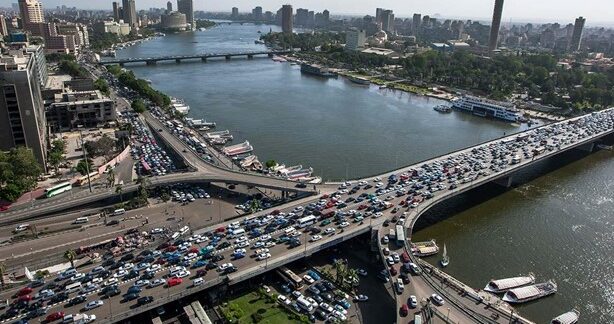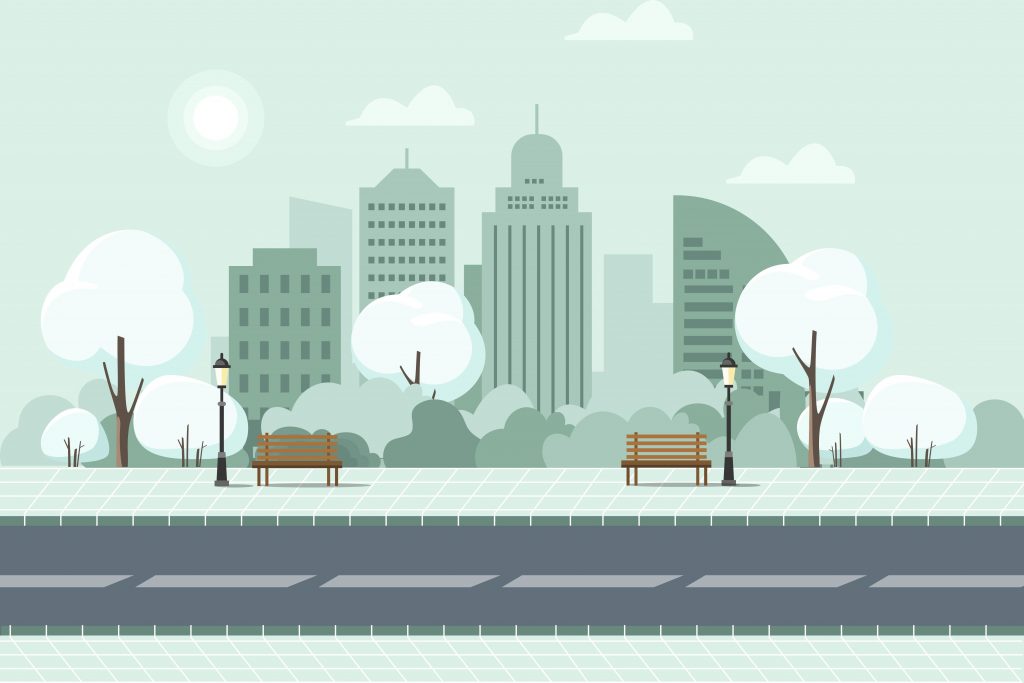As commuters across the Greater Cairo Metropolitan Area (GCMA) would attest, two things stand out about Egypt’s capital, home to more than 22 million people. The first is that traffic is a nightmare. In a research note, the World Bank estimated that Cairo’s traffic jams cost 4% of the country’s GDP, making Egypt among the countries most affected by traffic congestion. In New York and Jakarta, for example, gridlocks cost less than 1% of their respective GDP. The bank’s 2014 paper said: “Traffic congestion is a serious problem in the GCMA with large and adverse effects on both the quality of life and the economy.”
The second standout characteristic is roads and bridges proliferate at shocking rates. IDSC published a report in November 2021 saying the government had increased its investments in roads and bridges by 90% since 2019. President Abdel Fattah El-Sisi said in a televised speech in May 2021, “The reason for those investments is to “make people’s lives easier, so we can reduce the amount of lost time” spent in traffic jams.
Kyle Funk, senior program specialist for the National League of Cities, a U.S.-based organization, noted in an August blog: “Constructing more lanes on a highway [and building new ones] has been shown to have little to no impact on congestion levels.” A 2020 report from Transportation for America, an advocacy organization, found the United States increased the size of its roads in the country’s 100 biggest cities by 42% between 1993 and 2017, outpacing population growth rates, which increased 33%. Yet the number of lost hours in traffic jumped 144%.
Experts say an effective way to reduce congestion in a sustainable way lies with government regulations. They should encourage residents to use alternatives while making private cars less feasible. Meanwhile, private-sector innovation could offer new options.
Not solving congestion has severe repercussions for the economy. Ohio University published a paper in July 2022 noting, “Traffic congestion can cause compounding issues for delivery drivers and the supply chain, slowing the restocking of food and other essentials in communities that don’t have local resources. It may discourage new businesses … for fear of constant traffic.”
Inevitable congestion?
Matt Daus, president of the International Association of Transportation Regulators, noted the reason more roads can’t solve congestion is deep-rooted in almost all countries. “Since World War II, the vast majority of surface transportation planning and land use policy decisions … have been made primarily with private auto travel in mind,” he told Fleet Forward, a specialized online publication, in March 2022. “There has been a cyclical effect whereby auto dependence has led to auto-centric land-use planning decisions. [That], in turn, resulted in low-density suburban sprawl. The low-density nature of cities has led to further dependence on cars.”
The result is the increase in the number of cars on the road that has been outpacing population growth, with the gap between the two rates widening. In Egypt, CEIC, a data aggregator, calculated that between 1995 and 2019, the number of “registered vehicles” on the road quadrupled. Population growth rates during the same time reached 64.6%, according to CAPMAS.
Another reason for increased congestion on roads is the growth of e-commerce. A 2020 report from the World Economic Forum found that “growing demand for e-commerce delivery will result in 36% more delivery vehicles in inner cities by 2030.” It found that “traffic congestion [was] on track to increase by over 30%” if governments do nothing to reduce traffic jams.
Egypt is seeing e-commerce activity grow more than three times the GDP growth rate. Stratisica, a data-aggregating portal, said the sector’s revenue is “expected to show an annual growth … of 14.8% [through 2027].” That means e-commerce will grow from $7.54 billion this year to $13.1 billion in 2027.
Government fuel subsidies also help increase congestion. “Making gasoline and diesel prices inexpensive encourages more private cars on the road, and even large investments in highways will not keep pace with growing traffic congestion,” said the World Bank In a research note.
Another point is that urban planning in major cities in Egypt doesn’t provide enough parking spaces. The World Bank paper said: “Cars are either circulating or parked on the streets, thereby blocking traffic since there are no or few parking facilities.”
Acknowledging the need to tackle congestion, the Ministry of Transport has been widening roads and adding new routes and bridges. It has added and upgraded 7,000 kilometers (4,350 miles) of highways since 2014, when the current administration came to power. That is nearly 30% of Egypt’s 23,500 km road network. “One of the major aims behind the National Road Project is to relieve pressure … by constructing new desert roads … bypassing Cairo,” Ali Al-Biali, a professor of urban planning at Al-Azhar University, told Ahram English in March 2022.
That strategy could complicate the congestion problem. “We cannot build our way out of traffic congestion,” wrote Nicholas Klien, director of undergraduate studies in the City and Regional Planning Department at Cornell University, in Transfers Magazine in June 2022. “Adding new road capacity attracts more travelers from other modes, other times of day, and other routes … Adding new transit capacity does the same thing. A driver who leaves a busy rush hour freeway to ride a train will soon be replaced by someone else.”
Filling newly added capacity would further complicate incumbent factors that cause congestion. That list includes accidents blocking lanes, traffic jams due to poor weather conditions, unexpected spikes in commuters, bottlenecks due to varying widths of roads, and traffic control equipment breakdowns. “In many cases, multiple factors can occur at once,” said a 2020 U.S. Department of Transportation report. “One cause of traffic congestion can lead to another, such as when the onset of challenging weather for road travelers generates a rise in traffic as drivers rush home.”

Government solutions
“One of the easiest ways to improve traffic congestion is to remove [factors] arising from too many people trying to travel at once on any given road,” said the Ohio University paper
One solution is “more innovative road design [to] help direct the overflow of drivers onto side roads, reducing the chance of traffic congestion.” Another is to build “alternate routes to the same destination, [which] allows all streets to share the load of traffic.”
Those roads need to accommodate “alternate transportation infrastructure, such bus lanes, bike lanes, and sidewalks.” That could be achieved by “reducing the number of lanes available to private vehicles in favor of public transportation. Creating wholly separated streets or exclusive space more effectively streamlines traffic rather than simply painting lanes or messages on existing pavement.”
That requires significant investment, which could make innovatively-designed roads unfeasible. A Linkedin post noted that “many of these options are extremely expensive and time-consuming, so they may be out of reach for some communities,” according to RideShark, a transportation solutions provider, in a September paper.
The short-term solution likely will involve government regulations. Daus of the International Association of Transportation Regulators said charging for road use is a practical, low-cost, and short-term solution to congestion. Other fees that could reduce traffic jams inside cities include congestion and per-mile payments, where road users pay different amounts based on the amount of traffic already on the road or the distance traveled. Utah uses per-mile pricing on its streets, while London uses congestion charges to enter the city.
Such pricing is not a one-size-fits-all. Daus stressed: “The use of road pricing should be mindful to provide incentives for sustainability and equity goals,” such as exempting or reducing congestion fees for shared rides.”
Locals are unlikely to switch to public transport of their own accord. “Regulators and transportation policymakers should implement incentives and disincentives to encourage multimodal mobility.” That includes taxis, ride-hailing, carpooling, and buses. Additionally, the government should, whenever possible, “use public-private partnerships and … technology platforms to promote mobility as a service.”
Daus stressed that whatever the government does, it “must be carefully planned and based on actual customer needs [and budgets] as well as reduced fares, fees, and taxes.”
Private sector-led
The private sector has a significant role in new transportation solutions that reduce congestion on the road. One of the most common is ride-hailing services. The most popular in Egypt are Careem, Uber, and SWVL.
However, the Ohio University research stressed “ride-hail services could lead to decreased personal motor vehicle usage, it is important that these vehicles be utilized efficiently. [That means] minimizing ‘deadheading’ — driving around without passengers.” Additionally, only bus-hailing services (SWVL) could significantly impact congestion, as they have preset routes and can carry up to 14 passengers. “A low percentage of … [car-hailing] rides are not … shared with other passengers. Great potential exists … if this dynamic were to change.”
One service to solve the underutilization of ride-hailing is carpooling. It allows commuters to share a ride with another passenger going to the same (or nearby) destination, sharing the trip costs according to a preset scale. That is an enticing proposition for car owners with full-time jobs. They get to take the same daily route to work while reducing their commute costs by taking one or more passengers.
Another solution is for commuters to use electric scooters and bikes instead of private cars for short trips. “These solutions are often provided by private companies and do not require very much government investment or resource allocation,” noted RideShark. The downside is that it may “leave most rural [and suburban] communities feeling underserved” as those vehicles usually have a short range, making them most suitable for urban centers. They could also be expensive, making them unaffordable for a significant chunk of commuters.
Customized strategy
Tackling congestion in Egypt’s most crowded cities is complicated. The World Bank report says it spans “several ministries, governorates and government agencies, as well as public and private transport operation.”
The severity of traffic in Cairo and other major cities in the country means the government needs to work on short-term solutions to congestion in parallel with the “gradual implementation of longer-term solutions.”
One of those long-term solutions is to “allow … flexible work hours and the increased use of technology for remote business transactions, and further encouraging pedestrians and non-motorized means of transportation,” the World Bank said. “That would change the road usage patterns.”
However, the report stressed that the government needs to create an agency or authority to solve congestion problems nationwide. “Those solutions can only be implemented by dedicated urban transport institutions with a sufficient number of qualified staff,” the World Bank said. “World experience shows that cities that were most effective in reducing congestion (London, Paris) have delegated much of urban transport competencies and authority to a single Metropolitan Transport Authority.”
It’s “essential” function is to “lead the planning, regulation, and executive of key urban transport activities,” the World Bank said. “It also plays a central role in coordinating urban transport policies and activities with the various relevant agencies in the sector to have a coherent, efficient and integrated urban transport system.”
The report warns that solving congestion is increasingly urgent. Egypt “desperately needs such an authority with sufficient resources and power to move the urban transport agenda at the required fast pace to meet increasing congestion challenges.”








